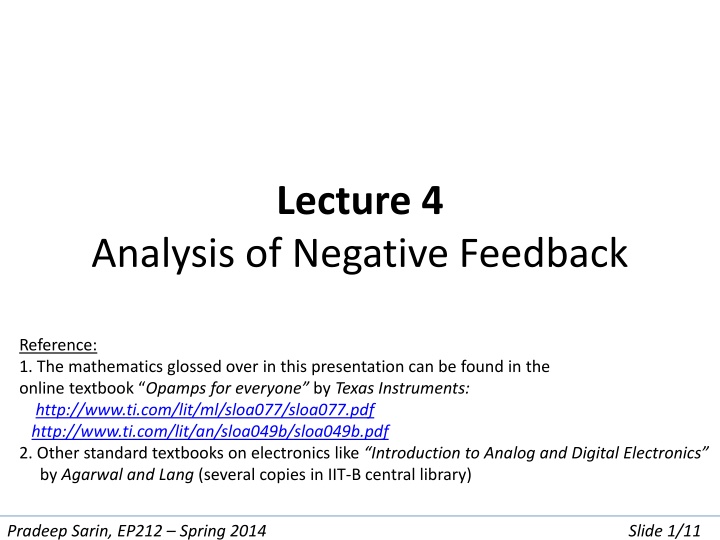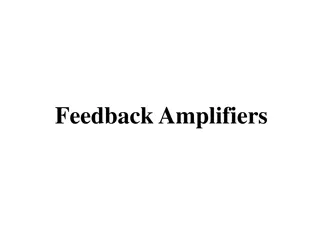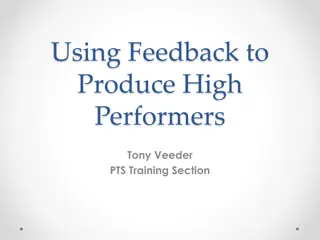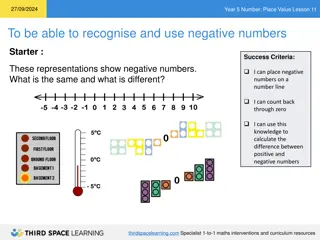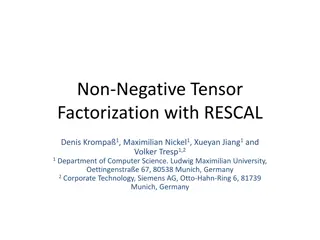Analysis of Negative Feedback
Dive into the analysis of negative feedback in electronics as discussed in Lecture 4, focusing on factors impacting loop gain, selecting resistor values, and the impact of feedback on amplifier performance.
Download Presentation

Please find below an Image/Link to download the presentation.
The content on the website is provided AS IS for your information and personal use only. It may not be sold, licensed, or shared on other websites without obtaining consent from the author.If you encounter any issues during the download, it is possible that the publisher has removed the file from their server.
You are allowed to download the files provided on this website for personal or commercial use, subject to the condition that they are used lawfully. All files are the property of their respective owners.
The content on the website is provided AS IS for your information and personal use only. It may not be sold, licensed, or shared on other websites without obtaining consent from the author.
E N D
Presentation Transcript
Lecture 4 Analysis of Negative Feedback Reference: 1. The mathematics glossed over in this presentation can be found in the online textbook Opamps for everyone by Texas Instruments: http://www.ti.com/lit/ml/sloa077/sloa077.pdf http://www.ti.com/lit/an/sloa049b/sloa049b.pdf 2. Other standard textbooks on electronics like Introduction to Analog and Digital Electronics by Agarwal and Lang (several copies in IIT-B central library) Pradeep Sarin, EP212 Spring 2014 Slide 1/11
R2/R1important what factors to consider when choosing Ri? R2small vo needs to source large current: subtracts from the current available to load. R2large parasitic capacitances in combination with large R introduce non-linear elements into the loop What is large R? What is small R? As a thumb rule, O(10k ) is OK. O(1 ) is small. O(1M ) is large. Pradeep Sarin, EP212 Spring 2014 Slide 2/11
Loop gain changes with frequency 10 Phase difference (degrees) Gain G 0 1 BODE plot 0.1 -45 -90 0.01 105 104 102 103 106 105 104 102 103 106 frequency (Hz) frequency (Hz) at unity gain = -115 Unity gain at 106 Hz Pradeep Sarin, EP212 Spring 2014 Slide 3/11
Bode plot summarizes the feedback loop characteristics For LM741 = 106 = 20 log10(106) = 120 dB AOL 20 dB/decade Gain (dB) AOL=1 log(f) Gain Bandwidth Product (GBWP) frequency at which gain = 1 : property of the device Units = Hz Useable range as an open loop amplifier For LM741, AOL = 120 dB, GBWP ~ 106 Hz at 20 dB/decade OL Gain starts dropping already at 1 Hz! Pradeep Sarin, EP212 Spring 2014 Slide 4/11
With feedback we increase the frequency range of operation AOL 40 dB/decade G=10 Gain (dB) G=1 log(f) Useable frequency range of amplifier has increased by decreasing gain to G=10 employing negative feedback Pradeep Sarin, EP212 Spring 2014 Slide 5/11
When does negative feedback (good) go bad (positive)? Generic negative Feedback loop vout= A a = A (vin Bvout) ???? ??? ? = 1 + ?? B can be a reactive/active circuit puts phase shift in the term Bvout If phase shift is 180 or more here, the - sign effectively becomes + : negative feedback will become positive! amplifier will oscillate with no vin(just noise) Pradeep Sarin, EP212 Spring 2014 Slide 6/11
How do you predict phase of negative feedback ? dominant pole AOL 0 Each pole introduces -90 of 20 dB/decade Gain (dB) Phase G=1 G=1 -90 log(f) log(f) AOL 0 < -90 40 dB/decade G=10 Gain (dB) Phase G=1 G=1 < -90 log(f) log(f) Pradeep Sarin, EP212 Spring 2014 Slide 7/11
When is an opamp unity gain stable? LM741 is Unity Gain Stable dominant pole AOL 0 Each pole introduces -90 of 20 dB/decade Gain (dB) Phase G=1 G=1 = -90 log(f) log(f) Dominant pole 0 AOL 20 dB/decade pole 2 Phase = -90 Gain (dB) 40 dB/decade phase margin: 180 - when G = 1 G=1 log(f) log(f) Pradeep Sarin, EP212 Spring 2014 Slide 8/11
How to choose an opamp? Design inputs: 1. What is the desired bandwidth? B 2. What is the desired gain? G c) Why is (b) necessary? Requirements: a) Choose an opamp with a GBWP of at least G B b) Look at the phase response of the chosen opamp in the data sheet, especially at high frequencies near B Is the phase margin sufficient? Phase margin (180 - ) at G=1, should be at least 45 in good design. Answer: You can control the design, but not vin ! For example stray noise can be of very high frequency, where the amplifier s phase shift may be > 180 If so, your circuit will oscillate. Pradeep Sarin, EP212 Spring 2014 Slide 9/11
Summary Today: Analysis of negative feedback Phase response, and why it matters phase shift in feedback loop > 180 can turn negative feedback into positive How to choose an opamp for a specific application Pradeep Sarin, EP212 Spring 2014 Slide 10/11
Reactive feedback is used in active filters R vin vout vin vout Lab 4 C Passive low-pass has G < 1 introduces phase Active low-pass Can set G 1 introduces phase http://www.analog.com/library/analogdialogue/archives/43-09/active_filters.pdf Pradeep Sarin, EP212 Spring 2014 Slide 11/11
